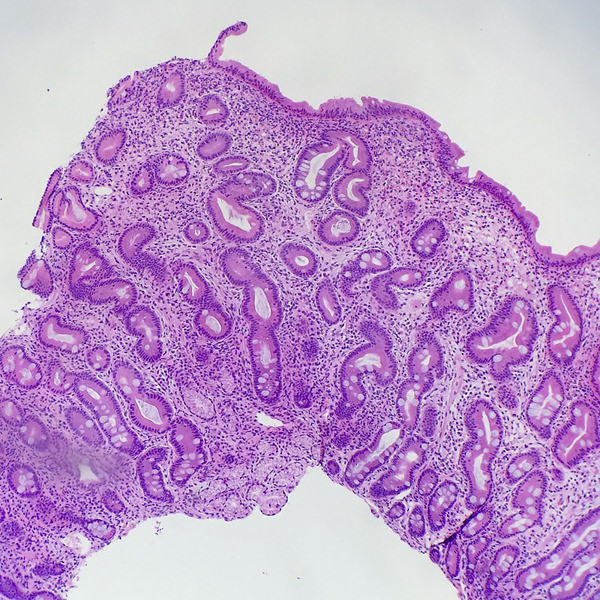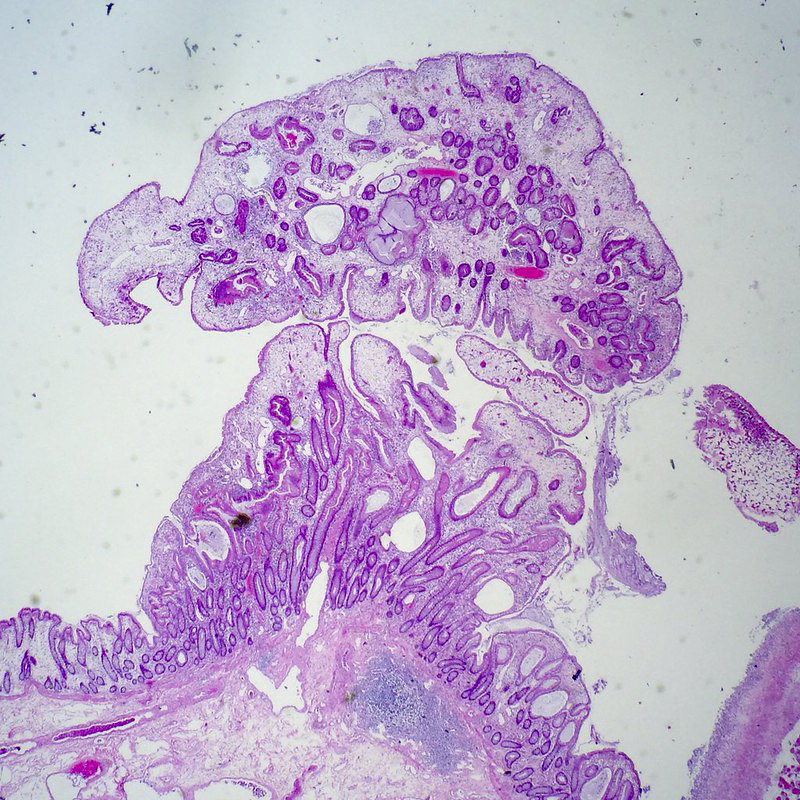Table of Contents
Definition / general | Essential features | Sites | Pathophysiology | Clinical features | Case reports | Clinical images | Microscopic (histologic) description | Microscopic (histologic) images | Differential diagnosis | Additional references | Board review style question #1 | Board review style answer #1 | Board review style question #2 | Board review style answer #2Cite this page: Feely M, Gonzalez RS. Cronkhite-Canada syndrome. PathologyOutlines.com website. https://www.pathologyoutlines.com/topic/colontumorcronkhite.html. Accessed May 12th, 2024.
Definition / general
- Rare, nonhereditary polyposis syndrome of unknown etiology
Essential features
- Disorder of middle adulthood, with mean age of diagnosis of 59 years
- Poor prognosis due to associated nutritional complications
- Up to 50% of patients have remissions
- Rarely has a fulminant course (Endoscopy 2010;42:E350)
- Associated carcinomas documented in 15 - 25% of cases (J Clin Pathol 2014;67:891)
Sites
- Polyps affect entire gastrointestinal tract, except the esophagus
- Also associated with ectodermal changes including alopecia, nail atrophy and cutaneous hyperpigmentation
Pathophysiology
- No known genetic link; considered nonhereditary
- May represent an autoimmune disorder (Digestion 2007;75:96)
Clinical features
- Patients present with variable symptoms, including diarrhea, weight loss, nausea, GI bleeding, protein losing enteropathy
Case reports
- 17 year old boy with late onset Cronkhite-Canada syndrome (Eur J Gastroenterol Hepatol 2005;17:1139)
- 54 year old woman with Cronkhite-Canada syndrome associated with myelodysplastic syndrome (World J Gastroenterol 2009;15:5871)
- 59 year old man with Cronkhite-Canada syndrome complicated with huge intramucosal gastric cancer (Gastric Cancer 2009;12:113)
- 63 year old woman with colorectal carcinoma in Cronkhite-Canada syndrome (Z Gastroenterol 2001;39:365)
- 70 year old woman with Cronkhite-Canada syndrome with adenomatous and carcinomatous transformation of colonic polyp (Indian J Gastroenterol 2003;22:189)
- 72 year old man with Cronkhite-Canada syndrome presenting with adenomatous and inflammatory colon polyps (Nat Rev Gastroenterol Hepatol 2010;7:460)
- Acute brain syndrome as a consequence of Cronkhite-Canada syndrome (Psychiatr Danub 2005;17:90)
Microscopic (histologic) description
- Multiple ill defined polyps with cystically dilated glands and crypts associated with an edematous lamina propria containing mononuclear cells and eosinophils, microscopically indistinguishable from juvenile polyps (Am J Surg Pathol 1989;13:940)
- Intervening nonpolypoid mucosa characteristically also has dilated glands, edema, congestion and inflammation (Gastroenterol Res Pract 2009;2009:619378)
Microscopic (histologic) images
Differential diagnosis
- Juvenile polyposis syndrome:
- Intervening nonpolypoid mucosa is histologically unremarkable
Additional references
Board review style question #1
Germline mutation in which of the following genes has been linked to Cronkhite-Canada syndrome?
- BRAF
- KRAS
- None (syndrome is nonhereditary)
- TP53
Board review style answer #1
Board review style question #2
The risk of developing carcinoma in patients with Cronkhite-Canada syndrome is approximately
- 0 - 5%
- 15 - 25%
- 40 - 50%
- 65 - 75%
Board review style answer #2












